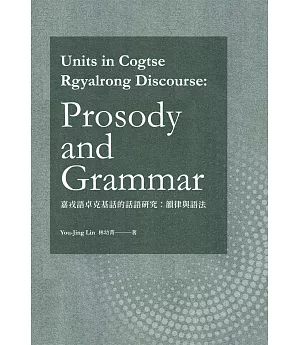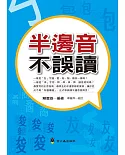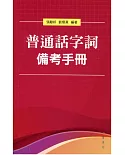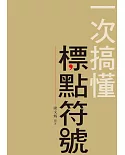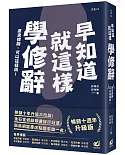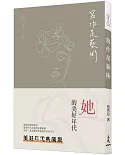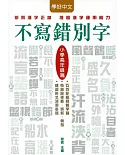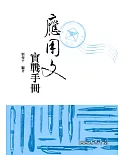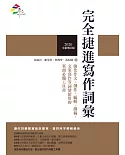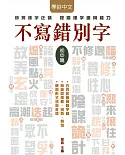嘉戎語為分佈於中國境內之漢藏語系語言,因擁有複雜的形態和語音結構為國際語言學界所知。本書以自發性口述材料為基礎,結合前沿韻律及語法研究理論,呈現嘉戎語如何將自然語流劃分出基本韻律單元,並且就這些單元的語法構造進行分析。研究發現,嘉戎語的詞韻律系統是一種降調與零聲調相對的缺性聲調系統;在此基礎上本研究進一步探討此聲調系統如何與其他音系特徵合作構建出語調的輪廓。與此同時,每一個韻律單元都就語法結構進行標記,以辨析此語言之首選結構類型。本書所呈現的研究,是漢藏語系語言學目前以即時自然語流為材料,針對韻律與語法性質最全面的研究;在世界語言的研究中,也是對缺性聲調對語調作用的探討也是首次。
作者介紹
作者簡介
You-Jing Lin 林幼菁
美國加州大學聖塔芭芭拉分校語言學博士,現任北京大學中國語言文學系副教授,主要教授課程為音系學、形態句法學、語言田野調查、以及中國境內的漢藏語系語言。主要研究中國西南地區的民族語言。目前已發表嘉戎語卓克基話的語法標注文集以及一系列學術論文,探討語法、音系、實驗語音學、以及語篇分析的問題,語言範圍涉及四土嘉戎語、茶堡嘉戎語、西部嘉戎語組語言、藏語、里汝語以及苗語。她有可能是率先研究中國境內藏緬語族語言韻律現象的第一人。
You-Jing Lin 林幼菁
美國加州大學聖塔芭芭拉分校語言學博士,現任北京大學中國語言文學系副教授,主要教授課程為音系學、形態句法學、語言田野調查、以及中國境內的漢藏語系語言。主要研究中國西南地區的民族語言。目前已發表嘉戎語卓克基話的語法標注文集以及一系列學術論文,探討語法、音系、實驗語音學、以及語篇分析的問題,語言範圍涉及四土嘉戎語、茶堡嘉戎語、西部嘉戎語組語言、藏語、里汝語以及苗語。她有可能是率先研究中國境內藏緬語族語言韻律現象的第一人。
目錄
Table of Contents i
Acknowledgements vii
Abstract ix
Chapter 1 General Introduction 1
1.0. Introduction 1
1.1. Cogtse Rgyalrong and Rgyalrongic Languages 3
1.2. Prosody 6
1.2.1. Intonation Unit (IU) 7
1.2.2. Intonation 8
1.2.3. Tone and Intonation 9
1.3. Grammar in the IU 11
1.4. General Research Questions 12
1.5. The Data 13
1.5.1. Spontaneous Narratives and Constructed Examples 13
1.5.2. Data Collection and Consultants 14
1.6. The Organization of the Book 19
Chapter 2 Word Prosody 21
2.0. Introduction 21
2.1. Previous Analyses of Cogtse Word Prosody 21
2.2. Typological and Analytical Problems with Pitch-Accent 30
2.3. A Privative Interpretation of Cogtse Tone 35
2.3.1. Surface-Melody 1 37
2.3.2. Surface-Melody 2 48
2 3 3. Grammatical Tonal Variations 55
2.3.3.1. Tonal Modification Preserving the Two-Way Contrast 56
2.3.3.1.1. Stem1-Stem2 Alternation 56
2.3.3.1.2. Toned Clitics: Dual and Plural Cliticization 60
2.3.3.1.3. Toneless Clitics 66
2.3.3.2. Partial Tone Retention: Compounding 67
2.3.3.3. Morphosyntactically-Assigned Tones 68
2.3.3.3.1. Observational 68
2.3.3.3.2. Indirect Evidential 70
2.3.3.3.3. Vocative Case 75
2.4. The Prosodic Phrase 75
2.4.1. Phrasal Modifications: Type 1 77
2.4.2. Phrasal Modifications: Type 2 83
2.4.3. Phrasal Modifications: Type 3 86
2 4 4. Phrasal Modifications: Type 4 94
2.5. Summary and Discussion 96
TABLE OF CONTENTS v iii
Chapter 3 Intonation Units: Segmentation and Intonation 99
3.0. Introduction 99
3.1. Labeling IU Boundaries 100
3.1.1. Prosodic Criteria for IU-boundary Identification 100
3.1.2. Inter-Rater Reliability Tests 103
3.2. Intonational Analysis 107
3.2.1. Phrasal Rules 109
3.2.2. Prosodic Accent 119
3.2.3. Boundary Tone 124
3.3. Summary and Discussion 139
Chapter 4 Intonation Units: Grammatical Structure 143
4.0. Introduction 143
4.1. Transcription System 147
4.1.1. Review of Some Major Transcription Systems 147
4.1.2. The Transcription System for Rgyalrong 152
4.2. Methodology: Coding Grammatical Types of the IU 156
4.3. Structural Types of the IU 165
4.3.1. Non-Clausal IUs 165
4.3.1.1. Nominal IUs 165
4.3.1.2. Discourse Markers 167
4.3.1.2.1. Connectives 167
4.3.1.2.2. Pause Fillers 168
4.3.1.2.3. Other Discourse Markers 169
4.3.1.3. Adverbials 170
4.3.1.4. Ideophone 172
4.3.1.5. Onomatopoeics 175
4.3.2. Clausal IUs 176
4.3.2.1. Mono-Clausal IUs 176
4.3.2.1.1. Fully Finite Clauses 176
4.3.2.1.2. Nominalized Finite Clauses 177
4.3.2.1.3. Non-Finite Clauses 186
4.3.2.1.4. Relative Clauses 190
4.3.2.1.5. Adverbial Clauses 194
4.3.2.2. Multi-Clausal IUs 196
4.3.2.2.1. Complex Sentences 196
4.3.2.2.2. Sequential Sentences 198
4.3.2.2.3. Juxtaposed Clauses 198
4.3.2.2.4. Super-Complex Clausal IUs 201
4.4. Distribution of Structural Types 202
4.5. Discussion of the Results 204
4.5.1. The Preferred Structural Type 204
4.5.2. Complex IUs vs. the “One Clause per IU” Tendency 205
4.6. Prosodic Correlations to Discourse and Grammar: Some Observations 211
4.6.1. Extrapropositional Expressions 211
4.6.2. Prosody-Grammar Correlation in the Quotative Construction 214
4.7. Summary and Conclusion 220
Chapter 5 Conclusion 223
5.0. Introduction 223
5.1. RQ1: How can Cogtse word prosody be best characterized?Is it tonal, pitch-accented, or both? 225
5.2. RQ2: How does prosody organize speech into basic units? 226
5.3. RQ3: What are the contour shapes observed on the Cogtse IU? How are they best described? 226
5.4. RQ4: What is the relationship between tone and intonation? 227
5.5. RQ5: What are the grammatical exponents of Cogtse IUs? What does the distribution of the structural types tell us about the grammatical organization of Cogtse natural speech? 227
5.6. RQ6: Is there any salient correlation between prosody and grammatical or discourse functions? 228
5.7. Contribution, Limitation, and Future Research 229
REFERENCES 233
Appendix: Three Cogtse Narratives 253
Acknowledgements vii
Abstract ix
Chapter 1 General Introduction 1
1.0. Introduction 1
1.1. Cogtse Rgyalrong and Rgyalrongic Languages 3
1.2. Prosody 6
1.2.1. Intonation Unit (IU) 7
1.2.2. Intonation 8
1.2.3. Tone and Intonation 9
1.3. Grammar in the IU 11
1.4. General Research Questions 12
1.5. The Data 13
1.5.1. Spontaneous Narratives and Constructed Examples 13
1.5.2. Data Collection and Consultants 14
1.6. The Organization of the Book 19
Chapter 2 Word Prosody 21
2.0. Introduction 21
2.1. Previous Analyses of Cogtse Word Prosody 21
2.2. Typological and Analytical Problems with Pitch-Accent 30
2.3. A Privative Interpretation of Cogtse Tone 35
2.3.1. Surface-Melody 1 37
2.3.2. Surface-Melody 2 48
2 3 3. Grammatical Tonal Variations 55
2.3.3.1. Tonal Modification Preserving the Two-Way Contrast 56
2.3.3.1.1. Stem1-Stem2 Alternation 56
2.3.3.1.2. Toned Clitics: Dual and Plural Cliticization 60
2.3.3.1.3. Toneless Clitics 66
2.3.3.2. Partial Tone Retention: Compounding 67
2.3.3.3. Morphosyntactically-Assigned Tones 68
2.3.3.3.1. Observational 68
2.3.3.3.2. Indirect Evidential 70
2.3.3.3.3. Vocative Case 75
2.4. The Prosodic Phrase 75
2.4.1. Phrasal Modifications: Type 1 77
2.4.2. Phrasal Modifications: Type 2 83
2.4.3. Phrasal Modifications: Type 3 86
2 4 4. Phrasal Modifications: Type 4 94
2.5. Summary and Discussion 96
TABLE OF CONTENTS v iii
Chapter 3 Intonation Units: Segmentation and Intonation 99
3.0. Introduction 99
3.1. Labeling IU Boundaries 100
3.1.1. Prosodic Criteria for IU-boundary Identification 100
3.1.2. Inter-Rater Reliability Tests 103
3.2. Intonational Analysis 107
3.2.1. Phrasal Rules 109
3.2.2. Prosodic Accent 119
3.2.3. Boundary Tone 124
3.3. Summary and Discussion 139
Chapter 4 Intonation Units: Grammatical Structure 143
4.0. Introduction 143
4.1. Transcription System 147
4.1.1. Review of Some Major Transcription Systems 147
4.1.2. The Transcription System for Rgyalrong 152
4.2. Methodology: Coding Grammatical Types of the IU 156
4.3. Structural Types of the IU 165
4.3.1. Non-Clausal IUs 165
4.3.1.1. Nominal IUs 165
4.3.1.2. Discourse Markers 167
4.3.1.2.1. Connectives 167
4.3.1.2.2. Pause Fillers 168
4.3.1.2.3. Other Discourse Markers 169
4.3.1.3. Adverbials 170
4.3.1.4. Ideophone 172
4.3.1.5. Onomatopoeics 175
4.3.2. Clausal IUs 176
4.3.2.1. Mono-Clausal IUs 176
4.3.2.1.1. Fully Finite Clauses 176
4.3.2.1.2. Nominalized Finite Clauses 177
4.3.2.1.3. Non-Finite Clauses 186
4.3.2.1.4. Relative Clauses 190
4.3.2.1.5. Adverbial Clauses 194
4.3.2.2. Multi-Clausal IUs 196
4.3.2.2.1. Complex Sentences 196
4.3.2.2.2. Sequential Sentences 198
4.3.2.2.3. Juxtaposed Clauses 198
4.3.2.2.4. Super-Complex Clausal IUs 201
4.4. Distribution of Structural Types 202
4.5. Discussion of the Results 204
4.5.1. The Preferred Structural Type 204
4.5.2. Complex IUs vs. the “One Clause per IU” Tendency 205
4.6. Prosodic Correlations to Discourse and Grammar: Some Observations 211
4.6.1. Extrapropositional Expressions 211
4.6.2. Prosody-Grammar Correlation in the Quotative Construction 214
4.7. Summary and Conclusion 220
Chapter 5 Conclusion 223
5.0. Introduction 223
5.1. RQ1: How can Cogtse word prosody be best characterized?Is it tonal, pitch-accented, or both? 225
5.2. RQ2: How does prosody organize speech into basic units? 226
5.3. RQ3: What are the contour shapes observed on the Cogtse IU? How are they best described? 226
5.4. RQ4: What is the relationship between tone and intonation? 227
5.5. RQ5: What are the grammatical exponents of Cogtse IUs? What does the distribution of the structural types tell us about the grammatical organization of Cogtse natural speech? 227
5.6. RQ6: Is there any salient correlation between prosody and grammatical or discourse functions? 228
5.7. Contribution, Limitation, and Future Research 229
REFERENCES 233
Appendix: Three Cogtse Narratives 253
網路書店
類別
折扣
價格
-
新書79折$379
-
新書79折$379
-
新書9折$432
-
新書9折$432

